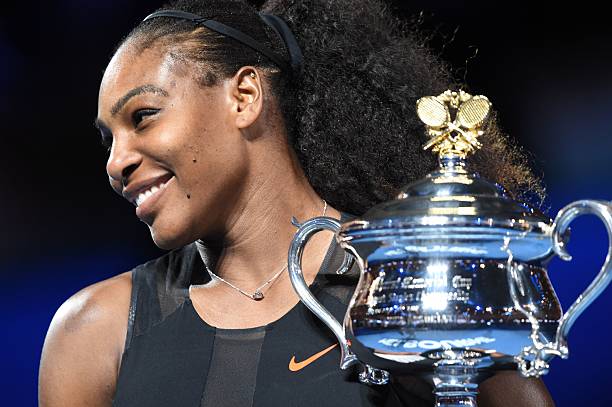Regardless of her ranking, the American’s unmistakable impact on the sport, and her unwavering approach to competition, make this a clear-cut selection.
In her first tournament appearance of the 2010s, in Sydney, Serena Williams said, “I definitely like to keep going when the going is tough. More than anything, I enjoy it. The moment I step on the court it’s like, this is what I was born to do. It’s what I do best.”
Those four sentences summed up Serena throughout the rest of the 2010s, a decade that saw her experience more jubilant highs and challenging lows, on and off the court, than most athletes experience in a lifetime.
How did she get through it all and come out on top? Her paramount shotmaking, world-class aptitude and preternatural gifts played significant roles. But it was her most empowering weapon—her relentless drive—that helped her most of all.
At the start of the 2010 season, Serena held 11 Grand Slam singles trophies. She quickly made the jump to 13 following successful title defenses at the Australian Open and Wimbledon, though her year was cut short after withstanding two separate surgeries on her right foot. Her time away from tennis was stretched to nearly a year when complications from a bilateral pulmonary embolism resulted in urgent treatment for a hematoma the size of a grapefruit.
Facing the “scariest moment of [her] life,” at the time, Serena refused to compromise, refused to look backward and refused to concede. Those qualities have propelled her to extraordinary comebacks, like when she was down a set and 4–0 to Victoria Azarenka in the 2010 Australian Open quarterfinals. None, however, were as profound or eminent as Serena’s return in June 2011.
The scoreboard would reflect losses at Eastbourne and Wimbledon; a strange No. 175 was beside her name. But for the woman who was “on her death bed at one point,” Serena’s desire to resume with what she was put on this planet to do was a courageous conquest, one that would outweigh all of the setbacks, the sobs and the skeptics—and ultimately serve as the impetus to becoming the greatest version of herself.
Serena won 10 Grand Slam singles titles over the next eight years, all after turning 30. At the 2012 Olympics, she put together one of her most comprehensive performances, punctuated with a 6–0, 6–1 demolition of Maria Sharapova, to join Steffi Graf as the only women to complete a career Golden Slam. She controlled the pulse of a fierce rivalry with Azarenka, denying the Belarusian in consecutive, compelling US Open finals.
At the 2010 Sydney event, Serena expressed something else to her fans.
“I always feel anxious,” she said.“I think it’s a good thing. I never want to become complacent and happy where I am. I always want to strive to do better and be better.”
That ambition reached its climax in 2015, when she clinched the second ‘Serena Slam’ of her career, and came within three sets of claiming a calendar-year Grand Slam at the US Open. After falling short in New York, she stayed away from the court, but unlike the Serena of the past, she provided the world an up close look at how that devastation affected her in the first of two documentary projects.
In a highly personal production, eponymously titled Serena, the walls of a confident champion were torn down. Viewers saw beneath the exterior of a superstar athlete, gaining unparalleled access to Serena, the person. She exposed the pain of missing out on the calendar-year Slam, showing that a sporting hero is just like the rest of us, where getting out of bed can be the day’s toughest task. She revealed that deep inside a competitor lies an inner child, one that gains pleasure in watching Disney movies. And she discussed not fitting the mold of a prototypical tennis player, and how she grew to embrace her differences as assets.
“I love my body,” she later said, “and I don’t really care about what anyone else says about it.”
More than anything, Serena reinforced that she is human. An imperfect soul who, love it or hate it, unapologetically approaches each mission one way: the Serena way. At Wimbledon in 2016, she tied Graf’s Open era record of 22 majors, then surpassed the legendary German in January 2017 when she defeated her older sister Venus to capture her seventh Australian Open.
Unbeknownst to the public, Serena was pregnant during that Melbourne run, and once again, the strength of her resilient voice prevailed after undergoing an emergency caesarian section to give birth to her daughter, Alexis Olympia. Experiencing shortness of breath, Serena implored doctors to run tests, believing a pulmonary embolism had resurfaced. Sure enough, her instincts were spot on, and she endured six days of complications before being released.
Since returning to the game in March 2018, Serena has been within striking distance of Margaret Court’s record 24 Grand Slam singles titles she’s played in four of the past six Grand Slam title matches. From a dispute with chair umpire Carlos Ramos in the 2018 US Open final to having her catsuit banned by Roland Garros, Serena’s pursuit of Court has not been without circumnavigating controversy.
But, as her reply to French Open officials showed at this year’s event— where the proud parent donned an outfit containing hidden messages with French words for “Mother,” “Queen,” “Goddess,”and “Champion”— the Compton, CA-raised conqueror will only reach Court’s mark in one manner: by marching ahead when the going gets tough. It’s the Serena way.













![Hotstar Premium Cookies 2019 [*100% Working & Daily Updated*] Hotstar Premium Cookies 2019 [*100% Working & Daily Updated*]](https://tahav.com/wp-content/uploads/2019/11/Hotstar-Premium-Cookies-Free-100x70.jpg)



